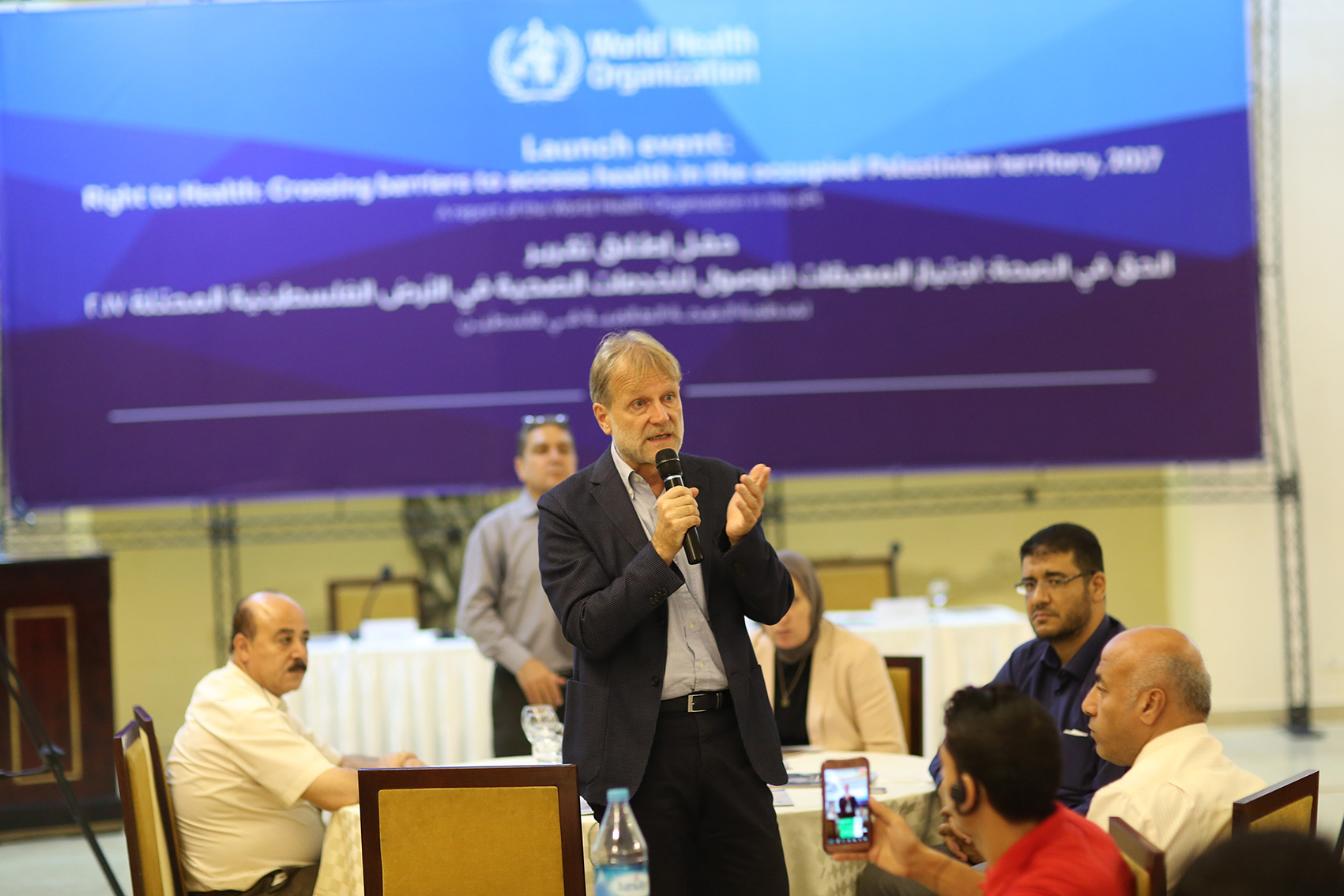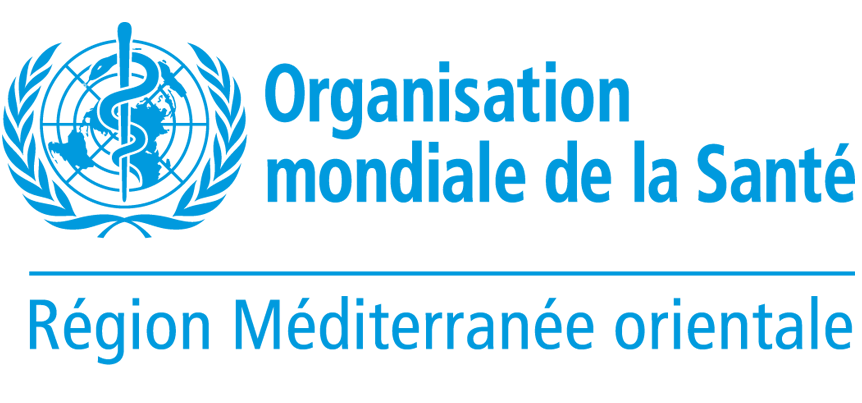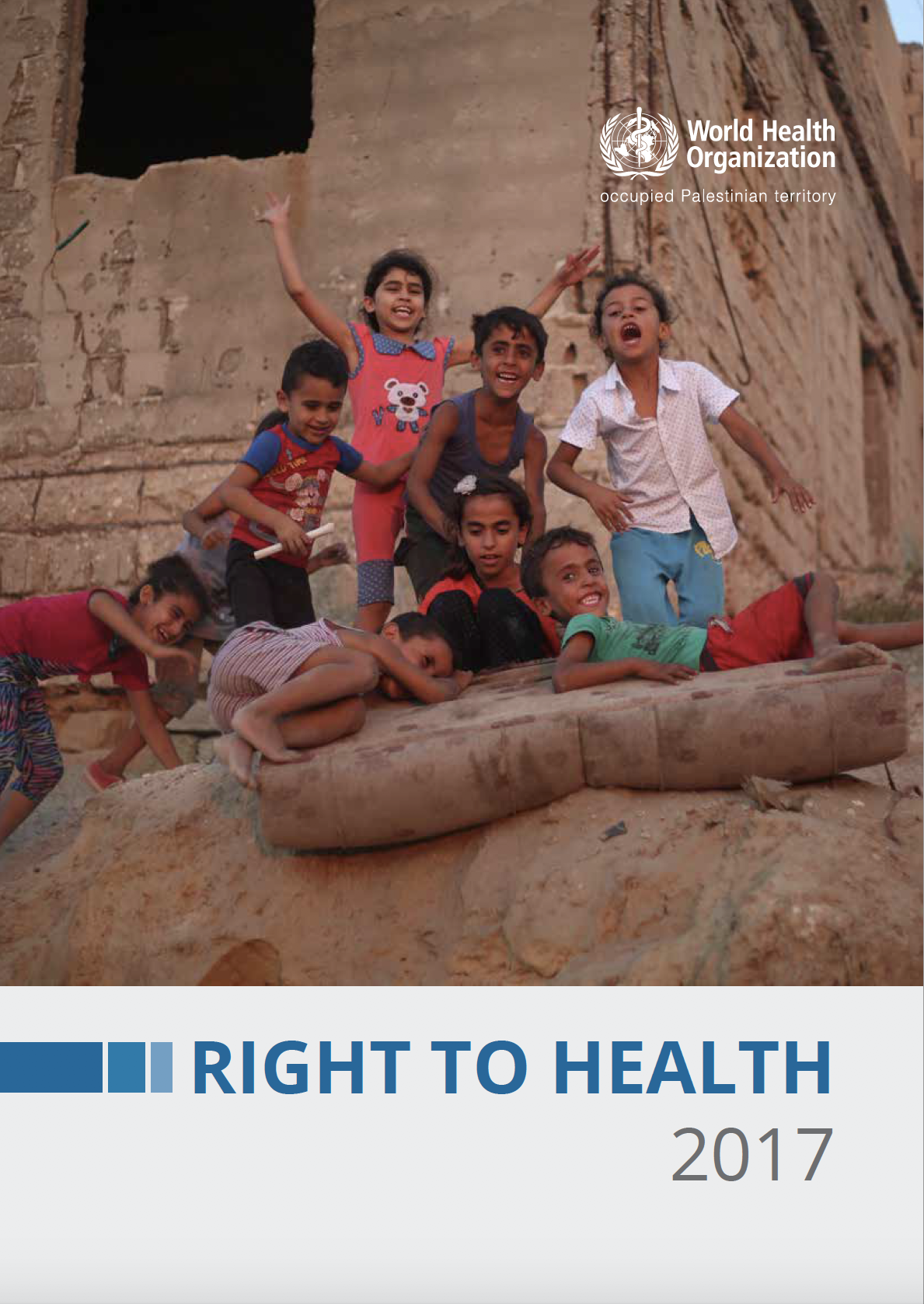WHO launches report on the Right to Health 2017, October 2018
 October 2018, Gaza – WHO today released its report, Right to Health: Crossing barriers to access health in the occupied Palestinian territory 2017. The report examines obstacles to achieving the highest attainable standard of health for Palestinians living under occupation, including barriers to health access and attacks on health care.
October 2018, Gaza – WHO today released its report, Right to Health: Crossing barriers to access health in the occupied Palestinian territory 2017. The report examines obstacles to achieving the highest attainable standard of health for Palestinians living under occupation, including barriers to health access and attacks on health care.
Dr Gerald Rockenschaub, Head of WHO in the occupied Palestinian territory, stated: “Enjoyment of the highest attainable standard of health is a fundamental right of every human being. Today’s report outlines major obstacles to achieving that right for Palestinians living under chronic occupation in the West Bank and Gaza Strip. In 2017, we have seen the lowest approval rate on record for Gaza patients needing access to hospitals in the West Bank, East Jerusalem and Israel. This year we have also witnessed a large number of attacks on health staff, ambulances and facilities, with the sad loss of three health colleagues killed while working to treat people injured during protests in the context of Gaza’s “Great March of Return”. We face major challenges in the health sector across the occupied Palestinian territory, with reductions in funding and a shrinking humanitarian space. This event is an opportunity for us to come together, to reflect on these challenges and to consider strategic actions in the coming months to bring about meaningful improvements for the health of Palestinians.'
The WHO report outlines key indicators for monitoring the right to health in the occupied Palestinian territory, and gives detailed analysis of the barriers to access for some of the most vulnerable Palestinian patients who require permits to access specialized health care. At the same event, WHO launched a book of photo stories on the right to health, which give accounts of individual patients and health workers and the difficulties they face. One story is that of Mohammad, a 7-year-old boy from Gaza with cancer in his right hip, and his grandmother Amal. Amal tells of the financial burden of traveling to East Jerusalem for care:
Jamie McGoldrick, the Humanitarian Coordinator and UN Resident Coordinator for the occupied Palestinian territory, stated: “Israel’s restrictions on the free movement of Palestinians and its permit regime has severe consequences for access to health care of an extremely vulnerable group of patients in need of specialist treatments and investigation not available in Gaza or in the West Bank outside of East Jerusalem. A third of these patients are referred for cancer care. A third of these patients are children and young people aged 19 years or under. Three-fifths of these patients faced at least one denial or delay of a permit application in 2017. Collectively we have a responsibility to insist that Palestinians enjoy full and equal rights and have unhindered access to services needed to promote health and wellbeing.”
For more information:contact the Advocacy team:
Related links
Annual report: Right to health
Right to Health photo book: Palestinian voices
WHO video-graphic: the journey of a referral patient from Gaza
WHO strengthens trauma care services in Gaza with support from the European Union, September 2018
 Photo: Patient is being stabilised at the Trauma Stabilisation Point (TSP) in the field, Credit: WHO13 September 2018 – With support from the European Union, the World Health Organization (WHO) is replenishing stocks of urgently-needed trauma medicines in Gaza, and providing hands-on training for health staff working in frontline trauma stabilization points (TSPs).
Photo: Patient is being stabilised at the Trauma Stabilisation Point (TSP) in the field, Credit: WHO13 September 2018 – With support from the European Union, the World Health Organization (WHO) is replenishing stocks of urgently-needed trauma medicines in Gaza, and providing hands-on training for health staff working in frontline trauma stabilization points (TSPs).
Life-saving medicines and medical supplies to treat more than 100 000 people have been delivered to hospitals and TSPs, filling critical gaps as supplies rapidly deplete as a result of increasing numbers of casualties injured in ongoing demonstrations within the context of the Great March of Return that started on 30 March 2018. In coordination with the Ministry of Health and the Palestinian Red Crescent Society, WHO supported the capacity-building of more than 60 health workers in 10 TSPs on emergency management of casualties at the TSPs and emergency rooms.
“The role of health workers at trauma stabilization points is crucial,” said Dr Gerald Rockenschaub, WHO’s Head of Office for Gaza and the West Bank. “Health staff in TSPs are usually the first to see wounded patients, and their capacity to resuscitate, stabilize, and treat patients with serious injuries can significantly increase patients’ chances of survival before they are referred to hospital for further medical care.”
From 30 March to the beginning of September 2018, more than 18 000 people have been injured during the ongoing demonstrations in Gaza. Of these, more than 8600 people were managed and directly discharged at TSPs, and almost 9500 referred by TSP health workers to hospitals for specialized care.
“When I was shot in the leg, I was taken to the closest trauma stabilization centre which was less than 5 minutes away. Doctors treated my injury and made sure I was stable enough to be taken to hospital. Without this immediate medical care to save my leg, I would have survived the journey to hospital, but my leg could have been permanently damaged,” said Waleed, one of the thousands of Palestinians treated at the TSPs.
“A chain is only as strong as its weakest link,” says Michelle Čičić, who oversees the EU’s humanitarian operations in Palestine. “It is critical that we are able to provide patients with life-saving care from the point of injury to the moment they are released from hospital. This serves to improve the health system in Gaza as a whole.”
To ensure a comprehensive and coordinated approach to the provision of trauma care in Gaza, WHO has established a dedicated Trauma Working Group with active participation from key partners delivering trauma care across the pathway. Different trauma sub-groups, focusing on areas such as reconstructive surgery and rehabilitation, bring together expertise and knowledge that will ensure quality emergency and trauma care for all injured.
Related infographics
WHO delivers anti-epileptic drugs to Gaza with the support of EU, September 2018
 The World Health Organization delivered anti-epileptic drugs to the Central Drugs Store of the Palestinian Ministry of Health in Gaza7 Sep 2018, Gaza – The World Health Organization delivered anti-epileptic drugs to the Central Drugs Store of the Palestinian Ministry of Health in Gaza on Wednesday 6 September. The procurement of anti-epileptic drugs and other essential psychotropic medicines (medicines used in the treatment of mental health) for the occupied Palestinian territory is a main component of the EU-funded WHO project Building Palestinian resilience: improving psychosocial and mental health responses to emergency situations.
The World Health Organization delivered anti-epileptic drugs to the Central Drugs Store of the Palestinian Ministry of Health in Gaza7 Sep 2018, Gaza – The World Health Organization delivered anti-epileptic drugs to the Central Drugs Store of the Palestinian Ministry of Health in Gaza on Wednesday 6 September. The procurement of anti-epileptic drugs and other essential psychotropic medicines (medicines used in the treatment of mental health) for the occupied Palestinian territory is a main component of the EU-funded WHO project Building Palestinian resilience: improving psychosocial and mental health responses to emergency situations.
Anti-epileptic drugs are the main type of treatment for most people with epilepsy, aimed at preventing seizures from happening. They are also used in the treatment of neuropathic pain, migraine and bipolar disorder. Epilepsy is a chronic disorder of the brain that affects people worldwide and is characterized by recurrent seizures. There are approximately 12,000 people in Gaza with epilepsy.
There continues to be a long-term shortage and depletion of medicines and medical disposables in Gaza, affecting access to effective health care for patients. In August, 50% of essential medicines, including anti-epileptic drugs, were critically depleted with less than a month’s stock remaining, according to Gaza’s Central Drugs Store. The Palestinian National Mental Health Strategy (2015-2019) recognizes that long-term shortages of psychotropic medicines represent a major challenge to the health sector, hindering the continuity of mental health services for patients in the occupied Palestinian territory. The procurement and delivery of essential medicines to treat mental illness forms a core component of the WHO Mental Health Project, which has utilized 800,000 Euros to deliver psychotropic medicines to the West Bank and Gaza in 2017-2018.
The WHO Mental Health Project aims to improve mental health services, including access to mental health services during emergencies. In addition to the procurement and delivery of essential medicines, the Palestinian Ministry of Health with WHO has developed a national emergency mental health plan and intervention guidelines, and delivered training to health professionals on the Mental Health Gap Action Programme, as well as training on the provision of psychological first aid to emergency medical teams.
Palestinian casualties of Gaza demonstrations
 The latest figures provided by the Ministry of Health indicate that 2 Palestinians were killed and 733 were injured by Israeli forces, during the demonstrations, from 14 to 27 August.
The latest figures provided by the Ministry of Health indicate that 2 Palestinians were killed and 733 were injured by Israeli forces, during the demonstrations, from 14 to 27 August.
Out of the total 733 injuries, 325 required transfer to Ministry of Health hospitals or nongovernmental organizations clinics, including 71 children and 22 females. From the hospitalized injuries, 6 people had critically life threatening injuries, 127 moderate, 187 mild, and the remaining 5 were unspecified cases.
The Ministry of Health and Palestinian Red Crescent Society set up 9 trauma stabilization points (TSPs). 408 injuries were managed and directly discharged at the TSPs. WHO continues to strengthen capacity of the TSPs across Gaza to provide life-saving interventions.
Gaza’s 14 public hospitals rely on donated fuel to run generators during the electricity black-outs, which last 18–20 hours per day. The last batch of United Nations donated fuel, approximately 370 000 litres, entered Gaza via Karem Shalom on 12 and 13 August; and there is currently no funding to procure more fuel. As a result, the UN-funded emergency fuel will completely deplete in less than 2 weeks, forcing public hospitals to significantly reduce essential services. Intensive care units, operating theatres and other critical units will face interruptions. This will be immediately life-threatening for over 4800 patients a month relying on electrical devices, including neonates in incubators. An additional 120 000 patients regularly receiving treatment at the hospitals will also be immediately affected and 1.27 million people relying on public secondary health care will be impacted. There is also an increased risk of waterborne disease and outbreaks across Gaza as fuel is also needed for sewage systems.
In July, the Central Drug Store of the Ministry of Health in Gaza reported that 48% of essential medicines were at less than one month’s supply and 40% were completely depleted. In addition, 29% of essential disposables were at less than one month’s supply.








 “I don’t dare to buy anything, but sometimes Muhammed asks to go to the cafeteria to buy a treat. I can only buy him the cheapest things… Much of the money goes on transport... Gaza has no work, no electricity, no water, nothing.”
“I don’t dare to buy anything, but sometimes Muhammed asks to go to the cafeteria to buy a treat. I can only buy him the cheapest things… Much of the money goes on transport... Gaza has no work, no electricity, no water, nothing.”